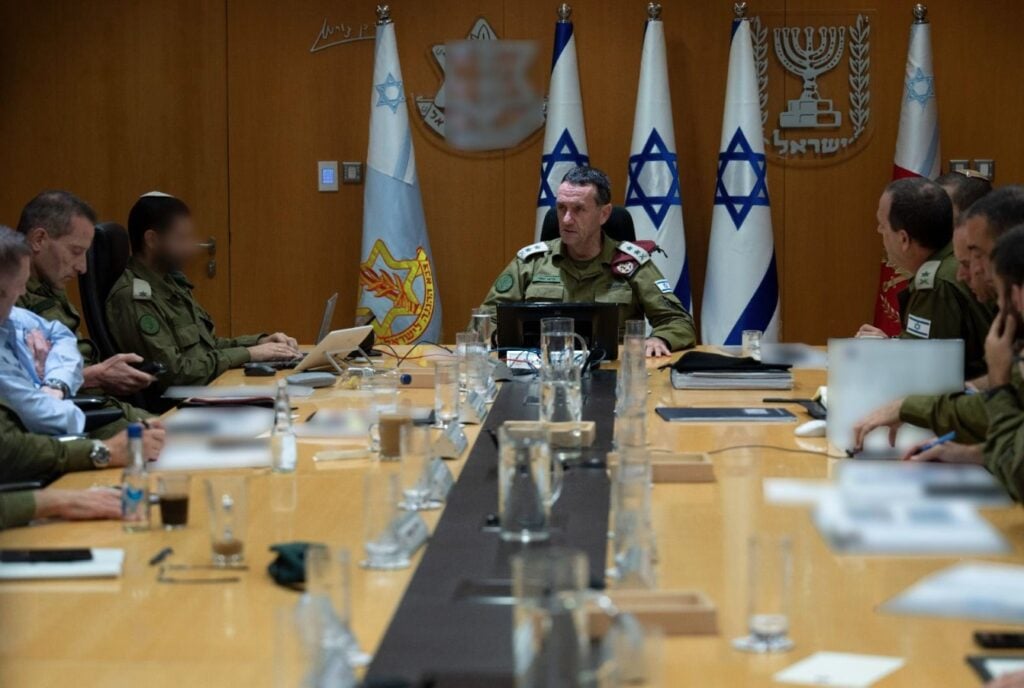The IDF carried out a remarkable operation, showing that Israel is viewing Hezbollah’s activities in real-time and can respond quickly to intelligence warnings.
By Yaakov Lappin, JNS
The Israeli Air Force’s major preemptive strike on Sunday, launched a little before 5 a.m. against Hezbollah positions in Southern Lebanon, was a stinging surprise to the Iranian-backed terror army.
However, despite this important achievement, and the welcome activation of preemptive steps, it is important to remember that the fundamental threat to Israel’s north remains in place.
Both Hezbollah and its Iranian sponsor are likely conducting an extensive situation assessment to gauge the damage that Hezbollah sustained, and to plot their next move.
Initial signs are that they wish to end this particular episode and regroup for the next stage of their war on Israel.
According to Lt. Col. Nadav Shoshani, Israel Defense Forces international spokesperson, the operation was a direct response to intelligence indicating that Hezbollah was preparing to launch an extensive missile and rocket attack on northern and central Israel.
The IDF has been closely monitoring Hezbollah and Iran attack capabilities, and remained on the highest state of alert in anticipation of an attack on Israel.
For weeks, the Iranian-led Shi’ite radical axis has been threatening to respond to the assassinations of Hezbollah chief of staff Fuad Shukr in Beirut on July 30 and Hamas Political Bureau chief Ismael Haniyeh in Tehran on July 31.
This swift and decisive action by the IDF, involving around 100 fighter jets, targeted thousands of Hezbollah rocket launchers across more than 40 launch areas in southern Lebanon, thwarting what could have been a significant assault on Israel.
Hezbollah was still able to fire hundreds of rockets and unmanned aerial vehicles towards northern Israeli communities on Sunday, but most of its attack was headed off by the IAF’s preemptive move.
Hezbollah’s preparations involved embedding rocket launchers within villages and towns across Southern Lebanon, thereby increasing the risk of collateral damage during any retaliatory strikes.
The IDF, which called Sunday on Lebanese civilians to move away from Hezbollah’s areas of activities, carried out a remarkable operation that not only destroyed a sizeable number of launchers but also proved, at the operational and intelligence level, that Israel is viewing Hezbollah’s activities in real time and can respond quickly to intelligence warnings.
Hezbollah had been preparing to fire rockets and missiles at Israel, with some reports indicating that these were intended to target key strategic locations in central Israel, including security and military installations.
Shoshani confirmed that most of Hezbollah’s planned attacks were intended to hit targets in northern Israel, and “some in central Israel.”
More than 7,000 projectiles
Shoshani highlighted that Hezbollah has fired more than 7,000 rockets, missiles and explosive UAVs at Israel since October 2023.
This is a reminder of the intolerable situation in northern Israel created by this Iranian proxy.
Taking advantage of Israel’s two-front conflict and the stretching of its military resources, Hezbollah has been able to turn an entire section of northern Israel a no-go zone for civilians for 10 months.
Some 60,000 Israelis remain internally displaced.
For Sunday’s intended attack, it appears that Hezbollah was planning to fire a combination of precision-guided ballistic missiles, UAV swarms and unguided rockets at valuable targets in Israel, such as military targets in the heart of a central Israeli city.
According to the Alma Research and Education Center, Hezbollah has thousands of precision projectiles, including the Iranian-supplied Fateh 110 missiles that have a range of 350 kilometers and which, if fired from Southern Lebanon, can hit central Israel.
Altogether, Hezbollah is believed to possess some 250,000 warheads, 150,000 of which are mortar rounds and 65,000 of which are rockets with ranges of up to 80 kilometers.
By demonstrating its willingness and ability to conduct large-scale operations preemptively, Israel sends a clear message to Hezbollah and its patrons in Tehran: Any significant imminent threat to Israeli civilians will be met with preventative force.
The question that remains is how Israel plans on restoring security to its north.
Hezbollah’s deep entrenchment in Southern Lebanon’s Shi’ite community, its conversion of some 200 southern Lebanese villages into bases of attack, and its ideological commitment to representing Iran’s Islamic Revolution all ensure that the threat will persist until Israel decides to deal with it strategically.
The international community also has a role to play in addressing the Iranian/Hezbollah’s jihadist war. Hezbollah and its Iranian patron threaten to drag Lebanon into a broader conflict, with devastating consequences for its civilian population.


